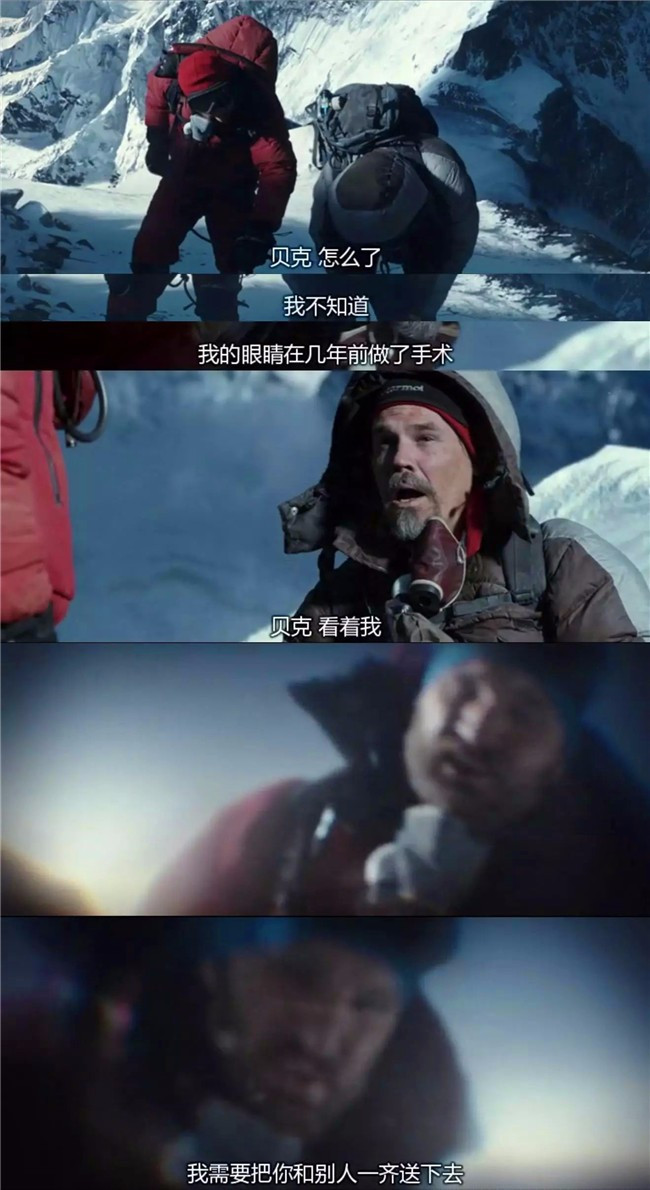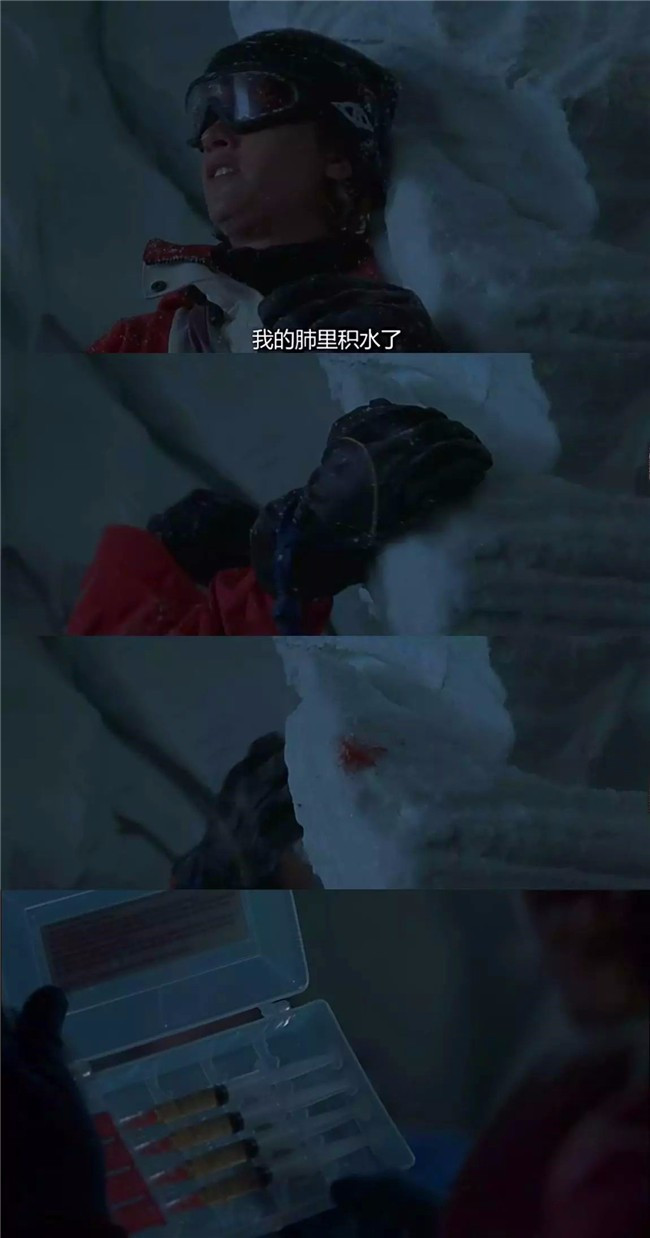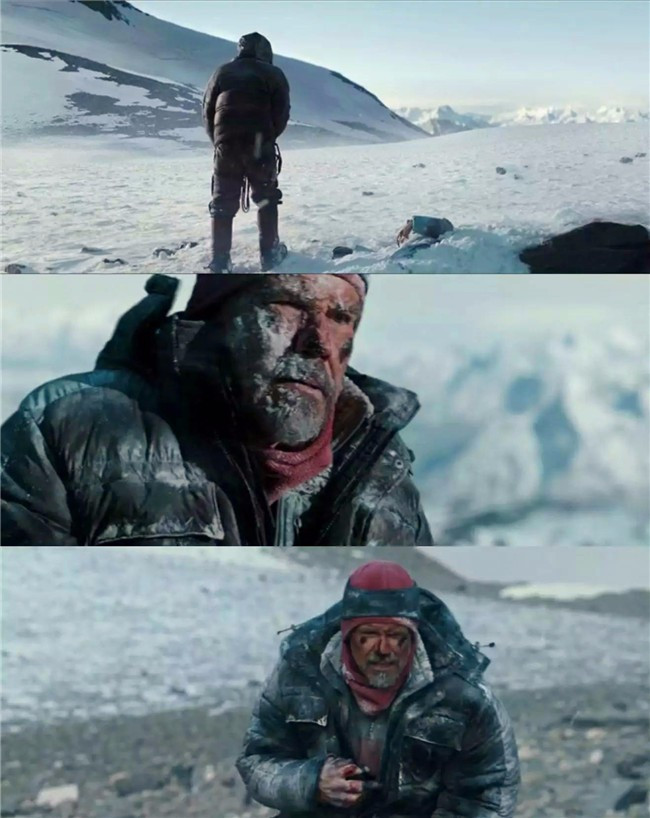Alpine adventures give climbers an extremely "cool" state, so many climbers will become obsessed with the sport. But at the same time, each participant is prepared to deal with the risks of alpine adventures.
Today we come to talk about common risks and countermeasures in the process of mountain adventures. I hope that you will be able to return home safely after enjoying the pleasures of the mountains.
Common risks and responses
Snow blindness
Solar ultraviolet (UV) can cause corneal burns, and UVB (short-wave ultraviolet) is also the culprit of snow blindness. Snow blindness is generally manifested as tearing, swelling, pain, acupuncture, sanding, light pain, headache, and decreased vision (fuzziness).

In the film "Destruction of Altitude," the protagonist Baker appeared in snow blindness, his eyesight gradually blurred, but he had no alternative but to rest in his place and wait for the withdrawal.
Snowblind prevention
Fog and cloudy can't block the projection of ultraviolet rays, even on cloudy or foggy days. Snow blindness occurs more often in fog or cloudy days than not because the ultraviolet light is stronger but because of the climber's carelessness, feeling light is not strong and reduces the sense of protection.
Long-term climbs also require a spare snow mirror to cope with the snow mirror's embossing or loss.
Snow blind treatment
Check for foreign matter and avoid rubbing your eyes.
Drop antibiotic eye drops and close your eyes and rest.
Wear eye masks.
Cold compresses may be useful.
Take painkillers when needed.
Rest at least 24 hours and re-examine after 24 hours.
If it becomes infected, take antibiotics 3-4 times daily.
In general, patients with mild snowblindness can completely disappear after 6 hours of treatment and rest; moderate to severe snowblind patients require 2 to 4 days of rest and treatment before symptoms disappear.
2. Altitude reaction
The altitude sickness is a normal physiological reaction that occurs when the human body maintains a constant internal environment in a low-pressure, low-oxygen environment. Symptoms of altitude sickness include headache, nausea, vomiting, anorexia, and difficulty sleeping.
Ways to prevent and reduce altitude sickness
Must have a positive attitude, reduce psychological pressure, and actively adapt.
The difference in elevation that rises every day should not be too large. Generally, the day should not exceed 500-799 meters. Strictly follow the principle of “high altitude activities and low campingâ€. The rate of increase should not be excessive, and the schedule should not be too tight.
Should have a reasonable amount of exercise, exercise intensity should not be too large to avoid sudden, explosive movements.
Always pay attention to wind and warmth, the cold stress response will increase the body's oxygen consumption, wind, cold-prone disease, will increase oxygen consumption, reduce resistance.
To have a reasonable diet, increase drinking water, eat more vitamins, avoid the loss of vitamins and calcium, and ensure sleep quality and quality. Do not eat greasy food, avoid fullness.
3. Pulmonary edema, brain edema
Pulmonary edema (HAPE)
There is an acute and severe altitude sickness before the occurrence of pulmonary edema. The pink foamy hernia is a serious symptom of pulmonary edema. Early pulmonary edema has the following symptoms:
Cough with white foam
During breathing, there are arpeggios, blisters, and buzzing sounds in the airways.
Shortness of breath
Lips, ear lobes, and fingernails, blue and purple.
Tired, lethargic
The pulse frequency becomes faster and can be accompanied by an irregular rhythm.

In the movie "Vertical Limit," the heroine trapped in a cliff suffers from pulmonary edema because she does not have enough drinking water. While coughing, he also coughed up his pink foam and relied on dexamethasone injection. He was finally rescued and evacuated to keep his life.
Brain edema symptoms (HACE)
Symptoms of cerebral edema include severe headache, ataxia, jet-like vomiting, and then entering a coma; some directly enter a coma from indifference and lethargy; extreme burnout, lethargy, gait instability, drunkenness, and inability to act can also occur. Symptoms such as rapid respiratory rate, cyanosis of the extremities and face, diplopia, oliguria, or involuntary urination may also be associated with symptoms.
Prevention of pulmonary edema, cerebral edema
Elevation should not be too fast and the trip should not be too tight.
The amount of exercise should not be too large when you first arrive at a high altitude.
Timely replenish moisture.
Reduce the intake of drugs and other foods in the respiratory circulatory system.
Eat liquid foods, not greasy, don't get full, add energy and vitamins.
keep warm.
Actively adapt.
Pulmonary edema, brain edema treatment
Immediate withdrawal, no delay.
There are three ways to determine effective: drop altitude, hyperbaric oxygen therapy, and oxygen therapy. Falling altitude is the most basic treatment. Hyperbaric oxygen chambers and oxygen therapy are temporary emergency methods.
The medicine will be a little help but not reliable.
Frostbite
Frostbite is a climber's overexposure to a low temperature in a limb during climbing. Low temperatures cause blood vessel and tissue freezing, tissue edema, blisters, ischemia, and tissue necrosis.
In medicine, frostbite is divided into 4 degrees according to the degree of frostbite:
Degree I frostbite: also known as "frost sores", damaged in the epidermis, skin redness and congestion in the frozen parts, consciously frostbite hot, itching, burning pain. Symptoms disappear after a few days, leaving no scars.
Degree II frostbite: Injuries to the superficial layers of the dermis. In addition to redness and swelling, frostbite is also accompanied by blisters. Deep edema can occur, severe pain, and skin feel dull. Can be cured after scarring
III degree frostbite: Injury to the subcutaneous tissue, red swelling and large blisters in the frostbite, black or purple brown in the frostbite, and loss of pain. III degree frostbite will cause irreversible damage to the tissue. In addition to leaving scars after the injury, there may be long-term hypersensitivity or pain.
IV Frostbite: Injuries to muscles and bones. Dry and wet gangrene occurs, resulting in amputation.

In the movie "Dead Sea", Baker suffered severe frostbite in climbing. The nose was finally cut and his hands were amputated.
Frostbite prevention methods
Frostbite often occurs at the end of limbs such as hands and feet. According to the principle of “choosing the right equipment to be the first element in climbing a mountain peakâ€, it is recommended that you choose to wear double-height mountain boots when climbing to peaks above 6,000 meters above sea level, and wear down and finger gloves in colder environments.
Keep your body dry. The feet are more prone to sweating, be sure to prepare dry spare socks, and dry socks are needed every day after arriving at the camp and starting.
Shoes, gloves, etc. can not be too tight, too tight will affect the blood circulation, increase the chance of frostbite.
Do not take off your gloves. More than half of the frostbite is caused by falling gloves or taking pictures after climbing.
Hypoxia can lead to capillary contraction, so that frostbite is more likely to occur, so oxygen in some degree can reduce the chance of frostbite.
Treatment of frostbite
To determine whether to rewarm: If the frostbite site is rewarmed, it may be frostbite again during the subsequent itinerary.
Trauma and walking can further aggravate the damage of frozen tissue.
The longer it is frozen, the greater the damage to the frostbite.
If the situation does not allow on-site rewarming, it should be noted that the frosted parts should be kept clean and dry, and use sterile tape to cover the frostbite and take antibiotics to prevent infection until rewarming.
Re-warming treatment: If a frostbite climber has arrived at the camp and the climbing team carries the medicine necessary to treat the frostbite, try rewarming the site of the frostbite. Rewarming is only required to soak the frostbite of the climber in warm water above 36°C. The water temperature should not exceed 4°C. Every 20-40 minutes, 2-3 times a day.
After rewarming: After the rewarming is completed, if there is a wound in the frostbite, it can be washed (cleaned) first with a disinfectant, then covered with the entire frostbite face (keeping it dry) with Yunnanbaiyao, and the frostbite is wrapped with gauze or a bandage. The frostbite area should be kept warm to prevent frostbite again. According to the condition, the dressing was changed once in 2 days. Frozen injured climbers can be given oral ibuprofen 400 mg three times daily.
Precautions after frostbite:
After the occurrence of frostbite, severely use snowballs and smashed frostbite. In the acute period of frostbite, the movement of the injured limb must be avoided to prevent damage to the external force. Once the acute inflammation is dissipated, the active joint (toe) should be acted as soon as possible to prevent joint stiffness and help restore muscle tone.
The cleanup of the wound is best done with saline instead of alcohol, iodophors are better than alcohol, and alcohol should be avoided.
When you are in high mountains,
Sustained and stable success results,
Not only courage and perseverance are needed,
It requires more self-knowledge and humility.
and so,
When the situation is not good,
Do not let past successes obscure your judgment.
Pack up equipment and safely withdraw.
The most important thing is to go home smoothly.
After all, the mountain is always there.
Kitchenaid 8 Burner Grill,Stainless Steel 8 Burner Grill,8 Burner Mini Island Grill,Burner Gas Grill
Jiangmen Merit Metal Electric Appliance Co.,Ltd. , https://www.meritbbq.com